| |
|
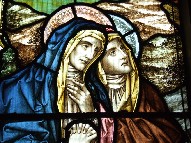 |
|
To see Melton from the
railway line, it is not the most enticing
of places, but be reassured that it has
not decided to challenge Great
Blakenham for the title of
Suffolk's most industrialised village.
Once you get beyond the detritus of
riverside industry, it is a very pleasant
place. You could argue that Melton today
is an industrialised suburb of the town Woodbridge,
but the village street still feels
reassuringly rural, especially since the
bypass was built. Until ten years ago,
this thundered under the weight of
traffic to and from the American bases,
on the other side of the River Deben from
here. Now, the Americans
are gone from East Suffolk.And it isn't
just the madness of the Cold War which
has touched Melton. For an older
generation of Suffolkers, Melton was the
home of the East Suffolk county lunatic
asylum, later St Audrey's Hospital, which
along with the railway provided 19th
century jobs here in abundance.
|
As
the village expanded towards Woodbridge, it left
its little medieval
church alone out in the fields; rather
than spend their money on a restoration to
enlarge it, the Parish decided to build a
completely new church, in the new heart of the
village. This happened more frequently in Norfolk
than it did in Suffolk - St Andrew is really
quite unusual. But I must say that this is not a
building I admire. The architect was Frederick
Barnes, best known for those wonderful railway
stations which he built on the line between
Ipswich and Cambridge, but the Kentish Ragstone
he used here is wholly inappropriate for a
Suffolk village. Be that as it may, the new St
Andrew is a well-used, well-loved church, and
there is much evidence of this inside its rather
dimly-lit interior.
The great feature of the
interior is the late medieval font which was
brought here from the old church. It is one
of Suffolk's 13 seven sacrament fonts, one of
only ten that have surviving imagery. It is
slightly more battered than many of its
companions, but it is particularly interesting
for its unique 8th panel, which shows the
martyrdom of St Andrew. It also has a
characterful 'last rites' panel, with a
chamberpot and a pair of slippers under the dying
man's bed, as at Badingham. This font
must have been one of the last of the series; the
vinework under the bowl is reminiscent of that on
the font at Walsoken in
Norfolk, one of the very last fonts to be made in
England before the Reformation intervened.
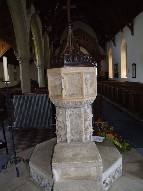 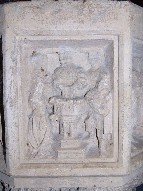 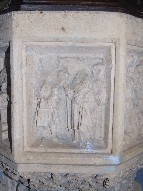 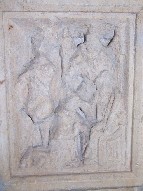 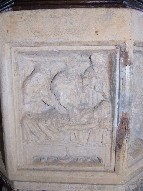
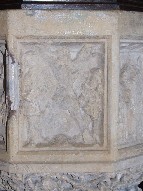 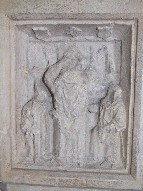 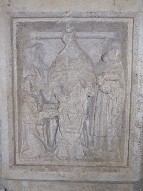 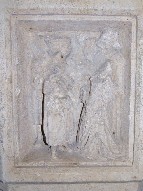 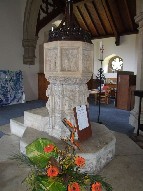
As
was fashionable, the church has a long, low north
aisle, its darkness alleviated by the dormer
window which lights it. There is some good turn
of the century glass, especially the Kempe window
to St Andrew and St Etheldreda flanking the risen
Christ. She is here because this parish was in
the liberty of St Etheldreda - that is to say,
the living was in the gift of the monks of Ely,
and this parish was in the Diocese of Ely after
the Reformation. The St Audrey of the hospital is
the self-same St Etheldreda, a medieval
contraction of the name. In the window, she holds
Ely Cathedral as it would look some one thousand
years after her death.
Further
west, the screen might well be the work of Cautley, installed
as it was in 1934 when he was at the height of
his influence as Diocesan Architect. Beyond, the
chancel has an Anglo-catholic twilight feel to
it, which is probably not typical of the current
style of the liturgy here.
| Melton parish was the
birthplace of one of the great unsung
heroes of English urban history. Edwin
Lankester was a mid-19th century doctor
and social scientist. He recognised a
correlation between poor water supply and
the London cholera epidemics of the
1850s, and was able to show that proper
sewerage and water treatment could lead
to the complete eradication of the
disease. It is him we have to thank for
our modern plumbing systems, and he
devised what is still today the standard
test for the purity of drinking water. As
coroner for the county of Middlesex, he
was the first to insist that every death
should result in a doctor issuing a
medical certificate. He was howled down
in parliament on the grounds of cost, but
today this is standard practice. His
son, Ray Lankester, was an even more
famous scientist, whose brilliant work as
a rationalist and zoologist was later to
be misused by militant atheists.
Lankester Junior was one of just eleven
friends to be present at the funeral of
Karl Marx, an unlikely association for a
rural Suffolk parish.
|
|
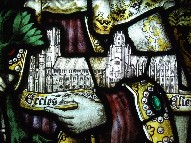 |
|
|
|

